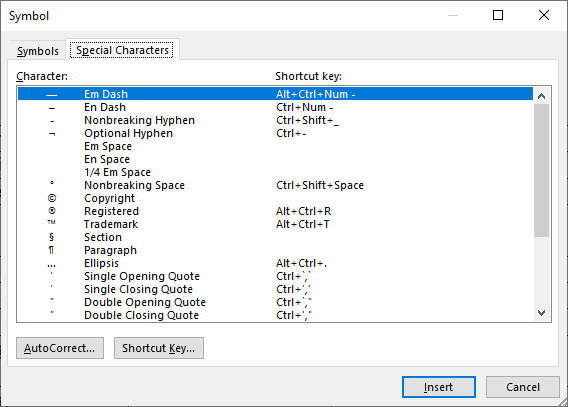3.7 Common Symbols
Using Special Characters in MS Word

Image Description
The image shows a “Symbol” dialogue box from a software application, likely Microsoft Word, under the “Special Characters” tab. The dialogue box contains a list of special characters with their corresponding shortcut keys. The list includes:
– Em Dash (Shortcut key: Alt+Ctrl+Num -)
– En Dash (Shortcut key: Ctrl+Num -)
– Nonbreaking Hyphen (Shortcut key: Ctrl+Shift+-)
– Optional Hyphen (Shortcut key: Ctrl+-)
– Em Space
– En Space
– 1/4 Em Space
– Nonbreaking Space (Shortcut key: Ctrl+Shift+Space)
– Copyright (Shortcut key: Alt+Ctrl+C)
– Registered (Shortcut key: Alt+Ctrl+R)
– Trademark (Shortcut key: Alt+Ctrl+T)
– Section
– Paragraph
– Ellipsis (Shortcut key: Alt+Ctrl+.)
– Single Opening Quote (Shortcut key: Ctrl+`)
– Single Closing Quote (Shortcut key: Ctrl+’)
– Double Opening Quote (Shortcut key: Ctrl+“
– Double Closing Quote (Shortcut key: Ctrl+”)
Below the list, there are buttons labelled “Insert,” “AutoCorrect,” and “Shortcut Key…,
Below are descriptions of some of the commonly used Special Characters.
Em dash
- Longest of the dashes, used to separate descriptive phrases that add meaning to the sentence but are not critical to the understanding of the sentence
- It is as long as an uppercase M character in the chosen font
- Similar to the use of commas and parentheses
Example
Mary —the one in the red coat—is my aunt.
En dash
- Is longer than a dash, shorter than an Em dash
- It is as long as an uppercase N character in the chosen font
- Commonly used between numbers, dates to indicate that something is up to or including
Examples
The surgery will be performed from 2:00 p.m.—4:00 p.m.
Hyphen
- The shortest of the dashes
- Used to connect words that are stand-alone words that have been connected to create a new idea
Examples
Some of the workers are part-time employees.
Part and time are both used elsewhere as single words with unique meanings, but when joined, they have different meanings.
Optional hyphen
- In Word found under Insert | Symbols | Special Characters
- Used to indicate where a word should divide if it is at the end of a line
- Generally visible with the use of the Show Hide option in Word if the word does not break throughout the line, but will become visible if the word does break at the end of a line
Examples
In a line where the word does not break: document
In a line where the word does break at the end of the line document
The visible hyphen appears automatically at the end of a line once it is added to the word as a special character.
Non-breaking hyphen
- Displays in the text docu-ment, and will not allow the word to break at the end of a line.
- At the end of the line, if the entire word cannot be on the line, the whole word is moved to the next line.
Examples
If the word fits on the line: docu‑ment
If the word does not fit on the line, the entire word is moved to the next line.
Also used for telephone numbers that use the dash to separate numbers: 519-123-4567, allowing the telephone number to always remain on the same line.
Em space and en space and ¼ em space
- Used if an author wanted various sizes of spaces, not generally used in business communications but is used in formal documentation
- Non-breaking space is used when words normally breaking at the end of line are forced to stay on the same line.
Examples
Since 2015, the prime minister of Canada has been Justin Pierre James Trudeau. The word Justin fits on the line above, it is being forced to stay connected with the full name, to make the name easier to read. The full name will not break over a line, all words will be moved to the next line.
This is how the text would appear with Show Hide active:


